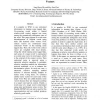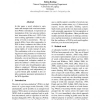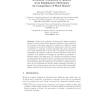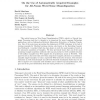221 search results - page 3 / 45 » Automatically Discovering Word Senses |
COLING
2002
13 years 5 months ago
2002
It is popular in WSD to use contextual information in training sense tagged data. Co-occurring words within a limited window-sized context support one sense among the semantically...
EACL
2006
ACL Anthology
13 years 6 months ago
2006
ACL Anthology
In this paper a novel solution to automatic and unsupervised word sense induction (WSI) is introduced. It represents an instantiation of the `one sense per collocation' obser...
IHI
2010
13 years 2 days ago
2010
Unsupervised word sense discrimination relies on the idea that words that occur in similar contexts will have similar meanings. These techniques cluster multiple contexts in which...
ERSHOV
2003
Springer
13 years 10 months ago
2003
Springer
Words in the explanatory dictionary have different meanings (senses) described using natural language definitions. If the definitions of two senses of the same word are too simi...
JAIR
2008
13 years 5 months ago
2008
This article focuses on Word Sense Disambiguation (WSD), which is a Natural Language Processing task that is thought to be important for many Language Technology applications, suc...




